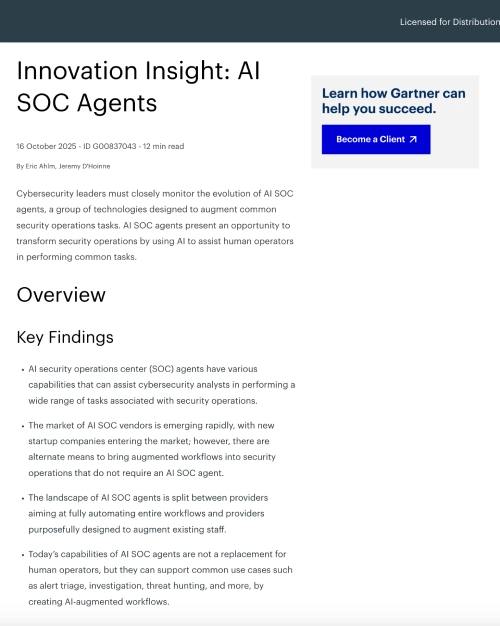
-min.webp)
AI SOC agents are getting executive attention because they claim to solve a real security operations problem: security teams are being asked to handle more alerts, investigate and respond faster, and document impact for leadership without adding headcount. In its recent "Innovation Insight: AI SOC Agents" report, Gartner highlights AI SOC agents as a solution to streamline security operations.
These agents are designed to automate repetitive tasks and standardize common procedures, enabling security analysts to accelerate their workflows and make more timely decisions. You can download a complementary copy of the Gartner report here.
The important nuance is that Gartner treats this as augmentation, not replacement. These systems are meant to help analysts triage, investigate, and explain activity with more speed and consistency. They still require human judgment and review.
In other words, doing more of the day to day operational work with the same team instead of hiring more headcount.
This article lays out the high level takeaways you should understand going into an AI SOC evaluation process. The full Gartner report goes deeper on evaluation criteria, expected risks, deployment models, and a representative list of vendors in this category.
{{ebook-cta}}
Gartner defines an AI SOC agent as software that uses AI to help analysts execute common SOC workflows. That includes alert triage, alert enrichment, guided scoping, timeline reconstruction, attack path mapping, and incident or case summarization for leadership and audit.
These agents sit on top of the tools and data you already run. They pull threat intelligence, asset and exposure context, past activity on that asset or identity, and relevant detection content. Then they present conclusions and next steps in plain language. Analysts can also run threat hunts, provide feedback and additional context, or ask follow up questions.
Current reality, according to Gartner, is that these products are not a full human replacement. They are best positioned as assistants that absorb repetitive work and lift the floor for less experienced analysts.
Gartner highlights several use cases where AI SOC agents are delivering meaningful value today. Each maps to a place where SOC teams lose time and consistency.
Gartner also calls out strategic benefits that matter at the leadership level. These include more consistent processes across analysts, a shorter ramp for less experienced staff, faster decisions on high signal events, and built-in capture of institutional knowledge so it does not walk out the door. Senior talent can spend more time on exposure reduction and tuning detections instead of clearing the alert inbox.
Buying an AI SOC agent is not the same as declaring you run an autonomous SOC. You still own oversight, judgment, and accountability.
There are four checks every security leader should run to see if AI SOC agents are the right fit for your team:
When considering the adoption of AI SOC agents, a crucial initial step is to assess the scale of your security operations workload and identify the specific pain points that these agents are best equipped to address. AI SOC agents are most effective when applied to scenarios characterized by high volumes of repetitive tasks, a need for rapid threat detection and response, and a desire to alleviate the burden on human analysts.
For organizations with a large influx of security alerts, AI SOC agents can significantly enhance the efficiency of the SOC. They excel at ingesting high volumes of alert data and other telemetry, correlating signal across tools, filtering out false positives, and narrowing analyst focus on what's important. This reduces alert fatigue and analyst burnout and frees up human analysts for strategic initiatives and proactive threat hunting.
Identifying success metrics for AI SOC agents is crucial for demonstrating their value and ensuring a positive return on investment. These metrics should directly link to how the agents improve specific security operations objectives, ultimately providing enough operational gains to offset the cost of the solution.
Key areas to consider when defining these metrics include:
When evaluating AI SOC agents, it's crucial to shift the focus from a feature-centric assessment to a use case-driven approach. Instead of meticulously comparing product features and functions in isolation, organizations should prioritize how these agents can demonstrably improve existing security operations center (SOC) workflows.
This means asking questions like:
Organizations must strategically adopt AI SOC agents to avoid vendor lock-in. Prioritize one-year subscriptions for flexibility, negotiation leverage, and to mitigate obsolescence. Crucially, decouple AI agent adoption from staff cost-cutting initiatives.
Get Gartner's guidance on evaluating and adopting AI SOC agents

